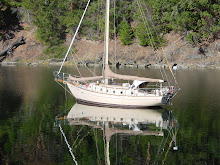La Paz, Baja California Sur (B.C.S.), Mexico
Not one of our best passages...
We raised our double-reefed main as soon as we were out of the harbour, but with little wind we just motor-sailed for the first few hours. As the winds came up a bit in the afternoon, we unfurled the genoa and sailed close-hauled in a NW breeze from about 1:30PM till 7:30PM, going mostly north, making little progress towards our actual destination. The seas were very smooth for the first few hours and it was very relaxing just sitting in the cockpit and letting the autopilot do all the work. Sue was sick of course, but not one of her worst bouts. As the day wore on the seas became much rougher and remained that way for the rest of the 51 hour passage.
With about 24 hours to go, somewhere in the middle of the Sea of Cortez, the autopilot quit, It still steered the boat for a few hours but got progressively less and less enthusiastic about its job. From what little I know about hydraulics, it appears to me that the hydraulic pump has bit the dust. I immediately hooked up our backup autopilot, the trusty old CPT wheel pilot. As luck would have it, it was no longer trusty; just old. I could not even get it to turn on, let alone steer the boat. So, for the remainder of the trip we were reduced to hand-steering - never any fun, especially at night.
For most of the time we motored into light winds (less than 8 knots). We were able to sail, close-hauled again, for about another 6 hours on the second afternoon. And again we made little progress in the direction we wanted to go, as the winds were always directly from the NW. The only good thing about the sailing was that it did make the motion in the increasingly rough seas a little better and I was able to balance the sails to the point that I could lash the wheel into a single position and let the boat steer itself for a few hours, giving the crew a much needed rest. The sunset on the 2nd night was really impressive.
Strangely, in spite of the increasingly warm days, the last night was quite cool. Because we were hand-steering, we elected to sleep in the cockpit and found that we needed some warm clothing - the first time we have worn long pants and fleece cozies since we got back to Mexico. Here you can see Susanne in her cocoon.
The last morning of the passage brought the most excitement. After rounding the north end of Cerralvo island, making our approach to the San Lorenzo Channel, conditions seemed to be perfect. For the first time in days the seas were dead calm and there was only a 3 knot breeze to contend with. I should note that as soon as you make this turn to the west, the wind also veers so that it comes from the west as well - some kind of Murphy's Law thing going on there.
As we approached the narrowest part of the channel, in about 50 feet of water, the wind started to come up and was soon blowing at around 17 to 18 knots, gusting to 25, from the SW now. As we were still motoring with only our double-reefed mainsail up, this was not really a problem - just slowed us down a bit. With the boat heeled over and the seas starting to build (lots of wind over relatively shallow water), this is the moment that the mainsheet (the line that controls to boom) decided to let go. The boom immediately shot over to the starboard side of the boat and commenced to swing the remains of the mainsheet and its blocks about, in an effort to decapitate the crew. As we were now in the narrowest part of the channel and had some large shipping traffic passing us, we had little room to maneuver, so we just had to keep motoring on until we got through to some calmer, deeper water before we could turn into the wind a bit more and take in some of the remaining mainsheet and get some control over the flailing blocks. Once we got the boom close to the cockpit, I managed to lasso the end of the boom and get it tied down to a cleat at the rear of the boat. Then it was relatively easy to lower the mainsail and get the boom into the gallows and tied down - crisis over. Needless to say, it would have been nice to have had the autopilot to do some steering throughout this affair, but we managed OK.
 |
| First sighting of La Paz |
The post mortem on the mainsheet shows that what went wrong was just a simple little cotter ring. It somehow worked its way out of the pin that holds the mainsheet to the traveller. Once the pin eased its way out of the traveller, there was nothing to hold the mainsheet any more. Fortunately, all of the parts just fell into the boat and nothing was lost. When putting the pin back in today, I replaced the cotter ring with a new one, although the old one really didn't look that bad. Just one more thing to keep an eye on in the future.
Our initial impression of La Paz? Hot! Daily highs are around 36C right now - not sure we are quite ready for that.
{GMST}24|9.3066|N|110|19.6068|W|La Paz, BCS, Mexico|La Paz, BCS, Mexico{GEND}









No comments:
Post a Comment